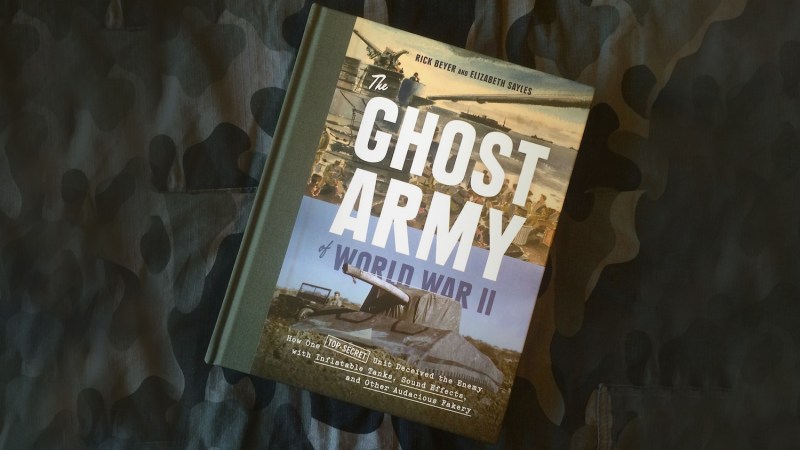
The title together with the brief description on the cover of Rick Beyer and Elizabeth Sayles’ book makes it abundantly clear what the book is about. It reads: The Ghost Army of World War II:
And that’s what the Twenty-Third Headquarters Special Troops (AKA the Ghost Army) did. First, let’s talk a bit about the Ghost Army itself and how these guys operated, then we’ll talk about the eponymous book and why you should read it.
Related:
The Ghost Army consisted of about 1,100 men. That’s battalion size, and in fact, is on the larger size for that unit type since most battalions are composed of between a few hundred to a thousand troops. With all of its trickery in action, however, this battalion could create the appearance of a force well over twenty times its size. Their job, quite simply, was to trick the enemies (in this case the German army of the Third Reich, AKA the Wehrmacht, AKA the Nazis) into thinking an army corp was deployed in a given area. That meant believing as many as twenty to forty or fifty thousand soldiers had mustered where, in reality, a fraction of that force was actually positioned. The idea was to siphon off a great deal of Wehrmacht effort from other locations, thus weakening German lines at critical junctures prior to allied advances, effecting needless use of enemy fuel and rations, stretching Nazi supply lines, and generally confusing one of the finest fighting forces the world had ever seen. Which was no easy task.

Fortunately, the gentlemen who made up the Twenty-Third Special Headquarters Division were some of the brightest, most dedicated soldiers in the United States Army. Which is kind of ironic, as most of them had been writers, cartoonists, newspaper editors, or scientists before WWII, and few had ever pictured themselves wearing army green.
The Ghost Army’s efforts involved three primary activities: the first was the use of physical objects to create the verisimilitude of troop activities; this included inflatable and wooden tanks, trucks, and other vehicles that could be quickly set up and moved about. The second was the use of sound effects — literally playing the sounds of tanks and trucks driving around via loudspeaker. And third, the Ghost Army mastered phony signal intelligence, broadcasting false information via radio, sending bogus telegraph messages, false reports meant to be intercepted, and more.

After the allied landings at Normandy in June of 1944, the men of the Ghost Army followed the “actual” troops (no disrespect intended, of course — these men were soldiers through and through, just fighting the war in a different way) as the breakout from the beachheads began. The real thrust into Europe began in August of that year, and one of the critical activities of the Twenty-Third Special was to approximate the presence of other units. They would regularly switch the patches on their uniforms and the markings on their (fake) vehicles, pretending one day to be the Sixth Army, another the Thirty-Seventh Field Artillery Battalion. It was in this latter capacity that the Ghost Army soldiers often displayed their true value and true grit; many nights the men would fire off phony flash canisters that simulated the firing of artillery pieces and then take shelter as real German artillery responded, raining down shells on the fake weapons and small gathering of real humans. Meanwhile, the actual allied artillery would be deployed miles away, taking no incoming fire and establishing itself in ideal positioning or maneuvering ahead as needed. This pattern would be repeated all across the Western Front through the end of the war in the spring of 1945.
The Ghost Army is a unique book in many ways, which is little surprise given its subject; but perhaps the most striking thing about this tome is the fact that it can be enjoyed in two distinct ways. The hardcover book is large — it is of what one would call coffee table proportions, measuring about eight by ten inches — and about 240 pages long. Those pages are an almost even blend of captioned photographs, sketches, maps, graphics, and pure text. You could flip through The Ghost Army reading only the captions and looking at the pictures and be left with a decent understanding of what the unit did and who comprised its ranks. Alternately, you could read the prose without glancing at a single image and come away with a thorough grasp of who they were and what they did.

But of course The Ghost Army is best enjoyed when every word is read and every image appreciated. That is especially so because of how colorful the men of the Twenty-Third Special Headquarters Division really were. How many other battalions featured dozens of cartoonists, photographers, and painters? Unlike most WWII units, which had occasional photos snapped of them by men and women working for Stars and Stripes or documenting the troops for military posterity, the Ghost Army was a self-documenting outfit, with everything from pencil sketches to watercolor paintings to photos capturing both the efforts and the essence of their time at war.
The writing itself is crisp and moves at a clip, though it often moves faster than a student of history might like. You will not come away from The Ghost Army with a scholar’s grasp of the latter years of the European theater of WWII, but you will have a solid understanding of this one unit’s role in the conflict. And you will also feel a connection to some of the individual men who served in the Ghost Army. Sayles and Beyer do an admirable job of coloring up many of their characters, picking the right details, using the right quotes, and pairing their text with the right images to humanize and contextualize these unique soldiers.
The The Ghost Army of World War II:



